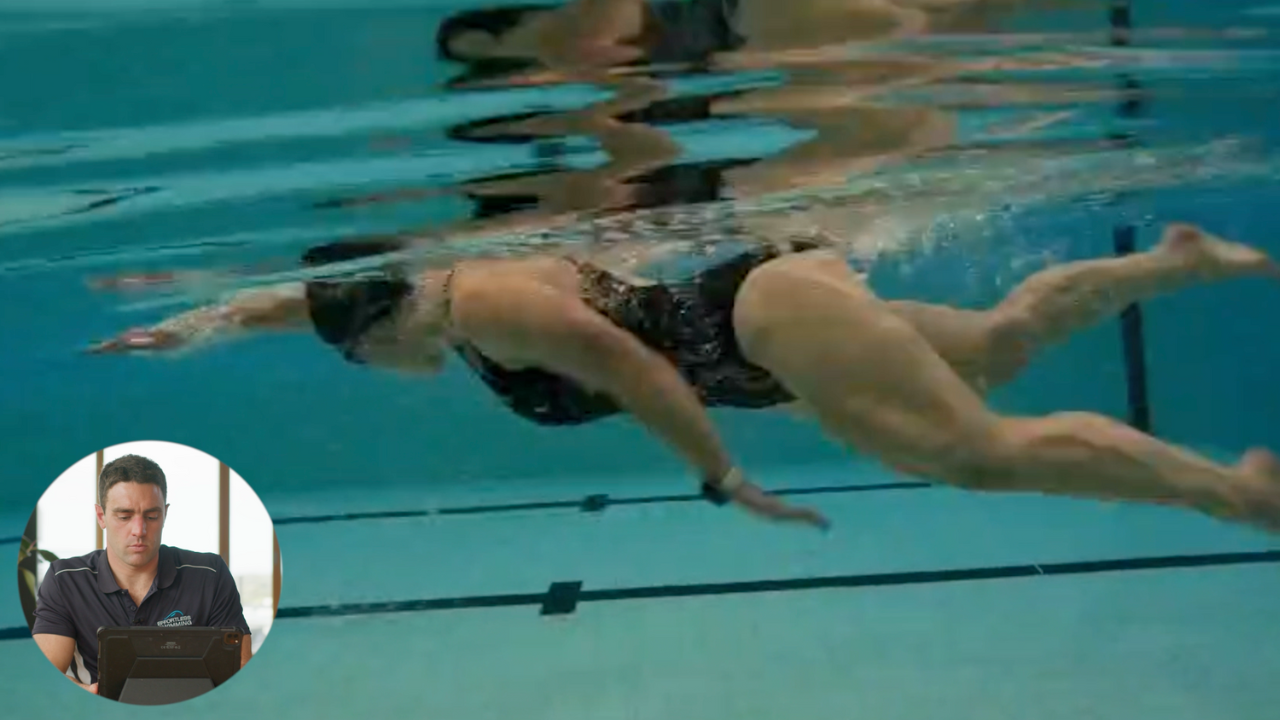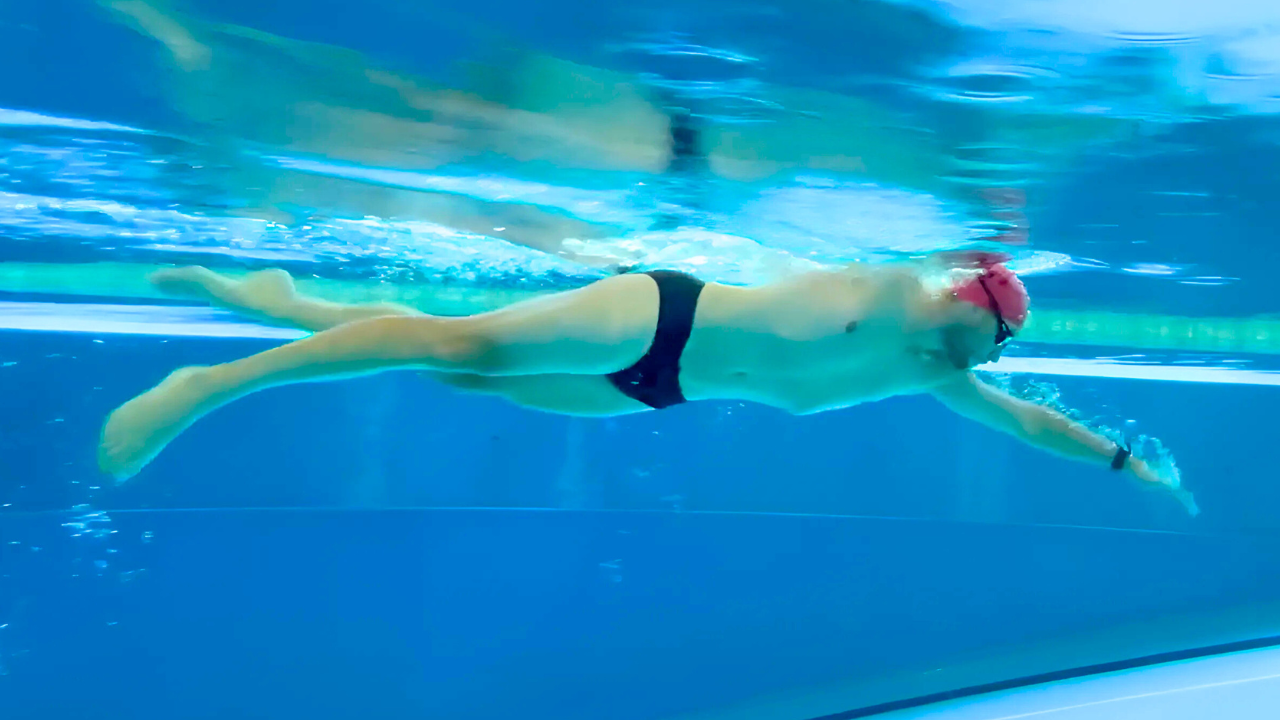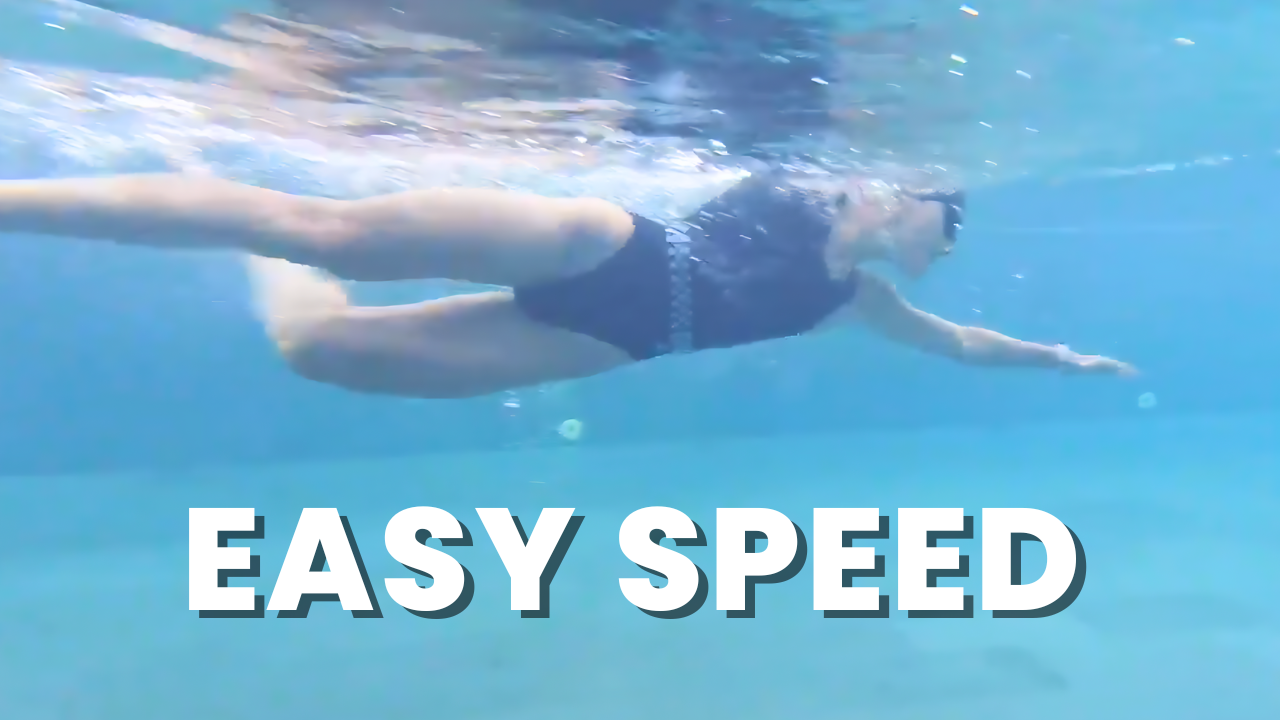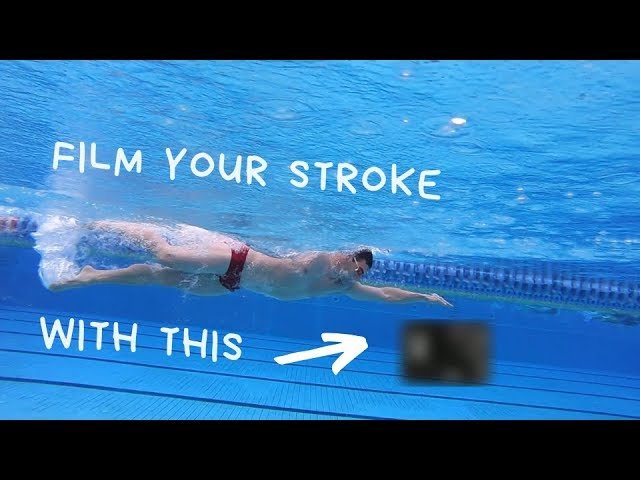See how you can use the 5 Core Principles Of Fast Freestyle to analyze your stroke and develop a roadmap for improving your swimming. In this episode of Feedback Friday, I look at a triathlete training for a full distance IM race in October.
Transcription:
You can do the YMCA drill that we’ve got in our video membership. That’s one of the key drills that I’m doing now. Hi, Brenton here from Effortless Swimming. In today’s video, I want to show you how you can use the five core principles to not only analyze your stroke, but also have a bit of a roadmap and action plan as to what should you work on in your own stroke. So in today’s video with Feedback Friday, we’re looking at a triathlete who’s training for an Ironman in October, currently averaging 135 per hundred yards across the Ironman distance when he does that in the pool.
So, the first core principle is breathe deep and relax. So in this principle, I like to look at how is someone breathing? Are they exhaling primarily through the nose? And does it look like they’re able to relax with their breathing, or do they seem a little bit panicked and rushed? You can see overall he’s quite comfortable in the water. It looks like he’s mostly exhaling through the nose there, and he’s releasing that air at a good time.
So just as he’s turning his head, he’s exhaling through the nose, and then by the time he goes to take that breath he’s pretty much emptied his lungs, able to get that breath quite quickly, and then he comes back in. So, from a breathing perspective, that looks really good. In terms of relaxation, the one thing I sort of look at here is from above the water, if I look at his … If I look between his shoulder blades, so in his upper back around here, he does look a little bit tense and tight there.
So we want to try and relax the muscles between the shoulder blades, or the upper back there. If that is too tight, then it can impact your breathing. But it really does impact how easily you come over the top of the water there, and it does sort of restrict your ability. Get the arms over the top of the water comfortably at a fast stroke rate, or a good stroke rate, if you are too tense there. So in swimming, we want to try and stay relaxed as we get faster. And it just looks like between the shoulder blades, there’s a little bit too much tension.
And in that Core Principle 1, breathe deep and relax, you want to be using your diaphragm. And part of that is having the right posture. So you need to lift your sternum, chest out, and relax between the back of the shoulder blades. So that would be the first thing I’d be looking to adjust there. Now, it might be the way he’s actually coming over the top of the water that is causing that, so I’m going to have a look at that in a moment. But that’d be the first thing I’d be looking to adjust by some of those five core principles.
The second core principle is, find your balance. So that really is, are you horizontal in the water? So, we don’t have the best underwater shot, but generally, you can see that the head, hips, and heels are all at the surface there. So from a body position perspective, generally pretty good. So there’s not too much that we’d need to adjust there.
The third core principle is, rock, return and align. So, with that, with the first one which is rock, that’s what I like to look at. Here we go, the swimmer coming towards us. And I like to look at the rotation. So, most top swimmers will rotate 35 to 45 degrees. It’s around that sort of range. You can see that rotation is pretty good. It’s a little bit under 39 degrees if I measured that correctly. And same on this side, similar thing. That’s about the right rotation. So, 47 degrees, that’s within the range. So that’s fine. So in terms of his rotation through his shoulders, that’s all looking good.
If we look at his hip rotation, again, that looks pretty good. He’s getting just enough rotation there to be able to get that cross-connection through the body. Maybe I’d rotate a little bit more through the hips, but for now, I think that’s fine. The return part of it is when the arm comes over the top of the water. So I’ve got rock, return and align. So with the return, that means your recovery over the top. Now, this is something that I would be looking at adjusting slightly.
So the first thing is on his left arm, you can see that he exits a little bit short. So the hand is exiting even just before the hip there. I’d be looking to press back a little bit further, and get that hand out of the water a bit sooner. Because you can see how the hand is actually getting dragged through the water there. And along with that, notice how this is a little bit jammed up through the shoulder. That’s going to make it harder to get the arm over the top of the water.
That’s why I like to aim for this open recovery, which means that there’s nothing wrong with that hand being out wider, being a little bit wider, sometimes a bit higher with the hand. I find a lot is, particularly adults, a lot of adults try and come too close to the body in their recovery, especially triathletes. You don’t need to do that. Just get that hand out wide. That’s a very easy way to come over the top of the water.
So with that return side of things, I’d be looking to press back a little bit further, maybe swing that hand around, make it feel very open and wide. And that’s an easy way to come over the top. And that’s also going to make it easier to relax between the shoulder blades there. Similar to this right side, it’s not too bad. He probably could inch a bit further out. That’s centering a little bit too close to the head. I’d be aiming somewhere a bit further out. You don’t want too much room to then slide forwards out in front. You just want that last little bit of the extension to happen in the water, and to me, that looks a little bit early there. So that is the return side of things.
In terms of alignment, that’s the next thing we look at. And I like to look at the hand entry. Is he entering and extending in line with the shoulders? And he’s doing a pretty good job of that. You can see that that left hand enters in line with the left shoulder, extends forward nicely, and then the right hand in line with that shoulder extending forward as well. So the alignment side of things is pretty much on track.
The next thing we look at or the next principle is #4, developing an effective catch and pull. So there’s a number of things that go along with that. And there are four key positions that I like to aim for in the catch and the pull. Now the first one, which I will show you here. It’s not the best angle, but this will do. As we come in … All right. So the first position that I like to get to is the starting catch position. And that should be fingers below your wrist, wrist below your elbow, elbow below your shoulder.
Now with both arms, there’s a tendency to have the fingers drift up, which we call putting the brakes on. And it just creates a lot of drag and resistance. So, see that position right there, where the fingertips are above the elbow. And all this resistance is going to be hitting the forearm there. So I’d be looking to work on that starting catch position, with some drills. You can just do a basic front kick drill, where you’re focused on getting your arms in the right position. You could do the YMCA drill that we’ve got in our video membership, that’s one of the key drills I’m doing now.
That starting catch position, I’d just be looking to work on that, make sure the fingertips are the deepest part of the arm in that starting catch position. The next position that we’re looking at is the sort of high elbow catch, and here he does a pretty good job of getting his left hand to drop down, just before he sort of starts pulling back with the elbow. So, not a bad position through here. It’s not the best angle for us to look at it here. It would be preferable to be side on here, but generally pretty good with that.
It’s really just that initial position where I think there’s a bit of resistance going on. It’s starting to slow him down, and he loses some of that flow in the stroke, and that rhythm in the stroke, because the fingers are drifting up. Now what I recommend for so many people that come to clinics is, if you’re doing that, get that hand down and make it feel very, very deep. That’s what you’ll have to make it feel like to actually change it. So if he tries to change it just a little bit, I bet you it’s not going to change at all. It’s one of those things that he’s probably going to have to exaggerate.
And that’d be a real key thing because I think you can just see that deceleration happening every time those fingers lift up or drift up there. So that’s going to be one of the main focuses of the stroke that I’d be looking to work on. The other thing here, there is room to go a bit deeper. When we look at this position, in terms of an angle, he’s not far away from where he should be. That angle is 97 degrees. We want it to be 100 to 120. To me, it looks like he’s probably just going just a little bit too shallow. I would be aiming to keep that upper arm where it is, but pretty much get that hand down a little bit lower.
Then on the right side, yeah, similar thing. You can just see, that angle’s a little bit too narrow. 92 degrees. We want it to be 100, maybe a little bit more. So just getting that hand down a little bit lower. And I find that happens quite a bit. So when you are trying to get this high elbow catch position, it’s common for people to try and keep the elbow up too close to the surface, or even just try and be too shallow with this catch.
A lot of times, you’re better off just going that little bit deeper with the hand to help you move over the top of it, and keep that momentum going in the stroke. So, you don’t want to have this sort of stop start every time you enter and extend and then pull through. You want to make it this nice continuous stroke, especially when it comes to long distance and open water. And if you don’t go deep enough, then it can make it hard to keep that momentum going.
Obviously, you don’t want to go too deep where you’re going down deep straight with the arm. But this sort of position where the hand is just … Your fingers are pointing that way, the angle is a little bit too narrow. We want to try and get that down just a bit more. So I’d be working on that. Again, the YMCA drill that we’ve got inside that video membership is a really good one for it. Then we also look at the exit of the hand. So with the exit of the hand, we saw before that that left one was occasionally going a little bit too short. It was exciting a little bit too early, where you can see it just coming out here. So that’s another thing that we would look to work on there.
Core Principle #5 is finding your rhythm and timing. The reason it’s finding your rhythm and timing, it’s different for everyone, so that means that your kick is going to be different from other people. It means that your stroke rate’s going to be different from other people. So we’d be looking at, all right, what might suit this swimmer best knowing that he’s going to be doing an Ironman swim in October, 3.8 ks, longer distance type of swim. Most likely going to have a wetsuit on. So what are those things that he might be looking to do?
One thing I’d be looking to test and looking to develop is to see how he goes with the four-beat kick. So at the moment, he’s got a six-beat kick, which is basically this … You’ve got three kicks per arm stroke, so it’s more of that continuous sort of kick. I’ve found a lot of swimmers have benefited from this four-beat kick, which is basically one kick on one arm stroke, three kicks on the other arm stroke. So that’s one, two, three, four. One, two, three, four. That can be a very, very good way to keep the speed up, keep the body position up, and also to save some energy, especially compared to a six-beat kick. So, that’s something that I’d be looking to explore, is that four-beat kick.
The other thing I’d be looking to do is, just really get that momentum up. So that would involve getting rid of this brakes on position, it would involve going a little bit deeper with the hands in that catch and pull phase of the stroke. And trying to get rid of … There’s a little bit of a pause out in front with both arms out there, just in this phase. So if we can kind of make that a bit more continuous. We don’t want to rush into the catch, but we also don’t wan to decelerate every time. Then that’s another way that’s he’s going to be able to keep the speed up, keep the heart rate down.
Because it’s actually more effort to have to decelerate and then get yourself going again. Much more effort to do that than get this nice rhythm and momentum going in the stroke by avoiding those fingers lifting up there. And also, just recovering that little bit wider. So that’s a way that I like to use those five core principles to analyze the stroke, and have a roadmap to working on certain things. So, the question I get a lot is, what’s the first thing I should really work on? And I use those five core principles as a way to sort of diagnose it and then give some structure around how you can work on your stroke.
And when I’m doing analysis with people inside our membership, that’s how I sort of go through it in my mind. So you can see the five core principles in our video memberships. Go ahead and check that out. And I hope you enjoyed this video. If you know someone that would benefit from this analysis, then make sure to like an subscribe and send this video to them. I appreciate you supporting the channel, and I’ll see you next week with another Feedback Friday.










